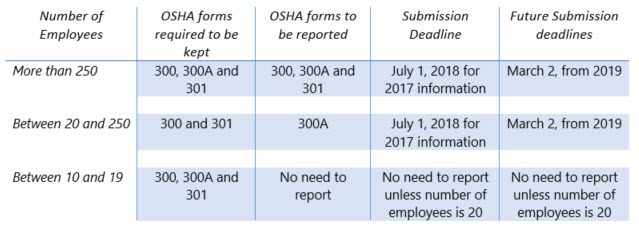The Occupational Safety and Health Administration (OSHA) goes through alternating cycles of regulation development and heavy inspection/enforcement action. Based on our observations the U.S. is currently in a high inspections/enforcement phase of the cycle. New OSHA electronic record-keeping rules, which came into effect on January 1, 2017, apply to all 50 states, territories and jurisdictions under federal authority. Those jurisdictions include the District of Columbia, Puerto Rico, the Virgin Islands, American Samoa, Guam, Northern Mariana Islands, Wake Island, Johnston Island, and the Outer Continental Shelf Lands as defined in the Outer Continental Shelf Lands Act. The new electronic record-keeping rules apply regardless of state or federal OSHA enforcement agency.
Employers with at least 10 employees need to be aware of the new reporting deadlines to prevent non-compliance and potential violations during this cycle of increased inspection and enforcement.
New Reporting Requirements and Deadlines
The three OSHA forms are:
- OSHA Form 300: Log of Work-Related Injuries and Illnesses
- OSHA Form 301: Injury and Illness Incident Report
- OSHA Form 300A: Summary of Work-Related Injuries and Illnesses
The new requirements for electronic record-keeping and reporting are dependent on the number of employees.
 Employers with more than 10 employees must post a copy of Form 300A in the workplace between February 1 and April 30. The form must summarize on-the-job injuries and illnesses during the previous calendar year. Even if employers do not have to submit yearly reports or logs, they are still subject to OSHA requirements and must report work-related fatalities, injuries and illnesses.
Employers with more than 10 employees must post a copy of Form 300A in the workplace between February 1 and April 30. The form must summarize on-the-job injuries and illnesses during the previous calendar year. Even if employers do not have to submit yearly reports or logs, they are still subject to OSHA requirements and must report work-related fatalities, injuries and illnesses.
Most Common OSHA Violation
The most common OSHA violation is an incorrectly completed OSHA form. Positive safety cultures encourage the reporting of at-risk behaviors and near misses. But, near-misses are just that: a miss, not an injury. If near-miss data is incorrectly included in your OSHA forms, that means your OSHA forms might be completed in error, even with the best of intentions.
For example, if the most common incident that occurs at your facility is a near-miss with lacerations from paper, and those occur ten times a week, but the most common recordable incident is running with scissors resulting in stitches once a month, the running-with-scissors trend will be obscured in your limiting your ability to accurately assess hazards and solutions.
The implications of the new recordkeeping requirements mean that
- recorded information provided will be publicly available;
- and the agency will have real-time injury and incident-rate information.
If your company’s incident rate exceeds your peer group’s rate, you could be targeted for an inspection.



